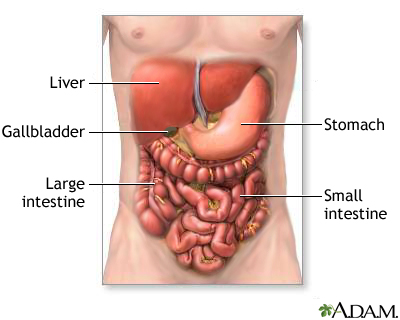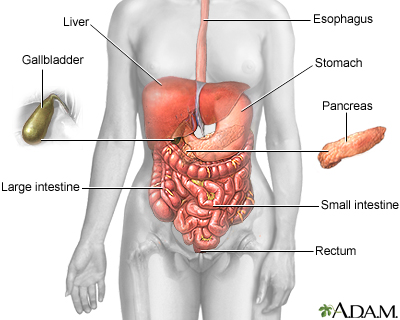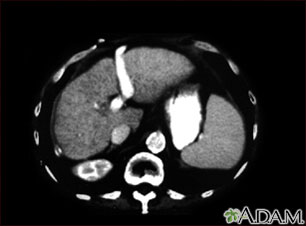Health Library
Cirrhosis
Liver cirrhosis; Chronic liver disease; End-stage liver disease; Liver failure - cirrhosis; Ascites - cirrhosis
Cirrhosis is scarring of the liver and poor liver function. It is the last stage of chronic liver disease.
Images



I Would Like to Learn About:
Causes
Cirrhosis is most often the end result of chronic liver damage caused by long-term (chronic) liver disease. Common causes of chronic liver disease in the United States are:
- Hepatitis B or hepatitis C infection.
- Alcohol abuse.
- Buildup of fat in the liver that is NOT caused by drinking too much alcohol (called nonalcoholic fatty liver disease [NAFLD] and nonalcoholic steatohepatitis [NASH]). It is closely related to being overweight, having high blood pressure, diabetes or pre-diabetes, and high cholesterol.
Less common causes of cirrhosis include:
- When immune cells mistake the liver's normal cells for harmful invaders and attack them, called autoimmune hepatitis (AH)
- Bile duct disorders
- Some medicines
- Liver diseases passed down in families
Symptoms
There may be no symptoms, or symptoms may come on slowly, depending on how well the liver is working. Often, it is discovered by chance when an x-ray is done or blood is drawn for another reason.
Early symptoms include:
- Fatigue and loss of energy
- Poor appetite and weight loss
- Nausea or belly pain
- Small, red spider-like blood vessels on the skin
As liver function worsens, symptoms may include:
- Fluid buildup in the legs (edema) and in the abdomen (ascites)
- Yellow color in the skin, mucous membranes, or eyes (jaundice)
- Redness on the palms of the hands
- In men, impotence, shrinking of the testicles, and breast swelling
- Easy bruising and abnormal bleeding, most often from swollen veins in the digestive tract
- Confusion or problems thinking
- Pale or clay-colored stools
- Bleeding from upper or lower intestinal tract
Exams and Tests
Your health care provider will do a physical exam to look for:
- An enlarged liver or spleen
- Excess breast tissue
- Swollen abdomen, as a result of too much fluid
- Reddened palms
- Red spider-like blood vessels on the skin
- Small testicles
- Widened veins in the abdomen wall
- Yellow eyes or skin (jaundice)
You may have the following tests to measure liver function:
Other tests to check for liver damage include:
- Computed tomography (CT) of the abdomen
- Magnetic resonance imaging (MRI) of the abdomen
- Endoscopy to check for abnormal veins in the esophagus or stomach
- Ultrasound of the abdomen
You might need a liver biopsy to confirm the diagnosis.
Treatment
LIFESTYLE CHANGES
Some things you can do to help take care of your liver disease are:
- Drink no alcohol.
- Eat a healthy diet that is low in salt, fat, and simple carbohydrates.
- Get vaccinated for diseases such as influenza, hepatitis A and B, and pneumococcal pneumonia.
- Talk to your provider about all medicines you take, including herbs and supplements and over-the-counter medicines.
- Exercise.
- Control your underlying metabolic problems, such as high blood pressure, diabetes, and high cholesterol.
MEDICINES FROM YOUR DOCTOR
- Water pills (diuretics) to get rid of fluid build-up
- Vitamin K or blood products to prevent excess bleeding
- Medicines for mental confusion
- Antibiotics for infections
OTHER TREATMENTS
- Endoscopic treatments for enlarged veins in the esophagus (varices)
- Removal of fluid from the abdomen (paracentesis)
- Placement of a transjugular intrahepatic portosystemic shunt (TIPS) to repair blood flow in the liver
When cirrhosis progresses to end-stage liver disease, a liver transplant may be needed.
Support Groups
You can often ease the stress of illness by joining a liver disease support group whose members share common experiences and problems.
Outlook (Prognosis)
Cirrhosis is caused by scarring of the liver. In most cases, the liver cannot heal or return to normal function once damage is severe. Cirrhosis can lead to serious complications.
Possible Complications
Complications may include:
- Bleeding disorders
- Buildup of fluid in the abdomen (ascites) and infection of the fluid (spontaneous bacterial peritonitis)
- Enlarged veins in the esophagus, stomach, or intestines that bleed easily (varices)
- Increased pressure in the blood vessels of the liver (portal hypertension)
- Kidney failure (hepatorenal syndrome)
- Liver cancer (hepatocellular carcinoma)
- Mental confusion, change in the level of consciousness, or coma (hepatic encephalopathy)
When to Contact a Medical Professional
Contact your provider if you develop symptoms of cirrhosis.
Get emergency medical help right away if you have:
- Abdominal or chest pain
- Abdominal swelling or ascites that is new or suddenly becomes worse
- A fever (temperature greater than 101°F or 38.3°C)
- Diarrhea
- Confusion or a change in alertness, or it gets worse
- Rectal bleeding, vomiting blood, or blood in the urine
- Shortness of breath
- Vomiting more than once a day
- Yellowing skin or eyes (jaundice) that is new or gets worse quickly
Prevention
DO NOT drink alcohol. Talk to your provider if you are worried about your drinking. Take steps to prevent getting hepatitis B or C or passing it to other people.
Related Information
Liver diseaseAscites
Bleeding disorders
High blood pressure - adults
Loss of brain function - liver disease
Alcohol use and safe drinking
Alcoholic liver disease
Bleeding esophageal varices
Decreased alertness
Sepsis
Liver cancer - hepatocellular carcinoma
Hepatorenal syndrome
Transjugular intrahepatic portosystemic shunt (TIPS)
Cirrhosis - discharge
References
Garcia-Tsao G. Cirrhosis and its sequelae. In: Goldman L, Schafer AI, eds. Goldman-Cecil Medicine. 26th ed. Philadelphia, PA: Elsevier; 2020:chap 144.
Kamath PS, Shah VH. Overview of cirrhosis. In: Feldman M, Friedman LS, Brandt LJ, eds. Sleisenger and Fordtran's Gastrointestinal and Liver Disease. 11th ed. Philadelphia, PA: Elsevier; 2021:chap 74.
Singal AK, Bataller R, Ahn J, Kamath PS, Shah VH. ACG Clinical Guideline: alcoholic liver disease. Am J Gastroenterol. 2018;113(2):175-194. PMID: 29336434 pubmed.ncbi.nlm.nih.gov/29336434/.
Wilson SR, Withers CE. The liver. In: Rumack CM, Levine D, eds. Diagnostic Ultrasound. 5th ed. Philadelphia, PA: Elsevier; 2018:chap 4.
BACK TO TOPReview Date: 2/6/2022
Reviewed By: Michael M. Phillips, MD, Emeritus Professor of Medicine, The George Washington University School of Medicine, Washington, DC. Also reviewed by David Zieve, MD, MHA, Medical Director, Brenda Conaway, Editorial Director, and the A.D.A.M. Editorial team.
 | A.D.A.M., Inc. is accredited by URAC, for Health Content Provider (www.urac.org). URAC's accreditation program is an independent audit to verify that A.D.A.M. follows rigorous standards of quality and accountability. A.D.A.M. is among the first to achieve this important distinction for online health information and services. Learn more about A.D.A.M.'s editorial policy, editorial process and privacy policy. A.D.A.M. is also a founding member of Hi-Ethics. This site complies with the HONcode standard for trustworthy health information: verify here. |
The information provided herein should not be used during any medical emergency or for the diagnosis or treatment of any medical condition. A licensed medical professional should be consulted for diagnosis and treatment of any and all medical conditions. Links to other sites are provided for information only -- they do not constitute endorsements of those other sites. © 1997- 2022 A.D.A.M., a business unit of Ebix, Inc. Any duplication or distribution of the information contained herein is strictly prohibited.
